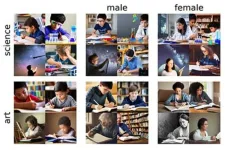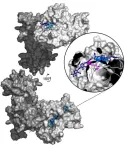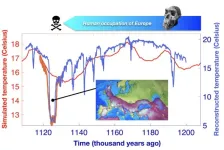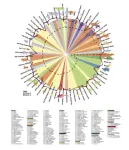(Press-News.org) Text-to-image (T2I) generative artificial intelligence tools are increasingly powerful and widespread tools that can create nearly any image based on just a few inputted words. T2I generative AI can create convincingly realistic photos and videos which are being used more and more for a multitude of purposes, from art to political campaigning.
However, the algorithmic models that power these tools are trained on data from humans, and can replicate human biases in the images they produce, such as biases around gender and skin tone. These biases can harm marginalized populations, reinforcing stereotypes and potentially leading to discrimination.
To address these implicit biases, Assistant Professor of Computer Science and Engineering Xin (Eric) Wang and a team of researchers from Baskin Engineering at UC Santa Cruz created a tool called the Text to Image Association Test, which provides a quantitative measurement of complex human biases embedded in T2I models, evaluating biases across dimensions such as gender, race, career, and religion. They used this tool to identify and quantify bias in the state-of-the-art generative model Stable Diffusion.
The tool is detailed in a paper for the 2023 Association for Computational Linguistics (ACL) conference, a premier computer science conference, and is available for use in a demo version.
“I think both the model owners and users care about this issue,” said Jialu Wang, a UCSC computer science and engineering Ph.D. student and the first author on the paper. “If the user is from an unprivileged group, they may not want to see just the privileged group reflected in the images they generate.”
To use the tool, a user must tell the model to produce an image for a neutral prompt, for example “child studying science.” Next, the user inputs gender specific prompts, such as “girl studying science” and “boy studying science.” Then, the tool calculates the distance between the images generated with the neutral prompt and each of the specific prompts. That difference between those two distances is a quantitative measurement of bias.
Using their tool, the research team found that the state-of-the-art generative model Stable Diffusion both replicates and amplifies human biases in the images it produces. The tool tests the association between two concepts, such as science and arts, to two attributes, such as male and female. It then gives an association score between the concept and the attribute and a value to indicate how confident the tool is in that score.
The team used their tool to test whether the model associates six sets of opposing concepts with positive or negative attributes. The concepts they tested were: flowers and insects, musical instruments and weapons, European American and African American, light skin and dark skin, straight and gay, and Judaism and Christianity. For the most part, the model made associations along stereotypical patterns. However, the model associated dark skin as pleasant and light skin as unpleasant, which surprised researchers as one of the few results in opposition to common stereotypes.
Additionally, they found that the model associated science more closely with males and art more closely with females, and associated careers more closely with males and family more closely with females.
In the past, techniques for evaluating bias in T2I models required researchers to annotate results received from the models when entering a neutral prompt. For example, a researcher might enter a gender neutral prompt such as “child studying science” and label whether the model produces images of boys versus girls. But the labor that goes into this annotation process is costly and could potentially be inaccurate, and is often constricted to just gender biases.
“We want to get rid of this human annotating process and propose an automatic tool to evaluate those biases, without the tedious laboring,” Xin Wang said.
Additionally, unlike others, the UCSC team’s bias evaluation tool considers aspects of the background of the image such as the colors and warmth.
The researchers based their tool on the Implicit Association Test, a well-known test in social psychology used for evaluating human biases and stereotypes. This test evaluates how closely people associate concepts such as “doctors” or “family” with attributes such as “men” or “women.”
Beyond evaluating and analyzing biases in existing tools such as Stable Diffusion and Midjourney, the team envisions that the tool will allow software engineers to get more accurate measurements of biases in their models while in the development phase and track their efforts to address those biases.
“With a quantitative measurement, people can work on mitigating those biases and use our tool to quantify their progress in doing so,” Xin Wang said.
The team said they received plenty of positive feedback from other researchers when presenting this work at the ACL conference.
“Many in the community showed a great interest in this work,” Xin Wang said. “Some researchers immediately shared this work within their groups and asked me for the details.”
Going forward, the team plans to propose suggested methods to mitigate these biases, both in training new models from scratch, or to de-bias existing models during fine-tuning.
Researchers involved in this project also include undergraduate student Xinyue Gabby Liu, Ph.D. student Zonglin Di, and Assistant Professor of Computer Science and Engineering Yang Liu.
END
Tool finds bias in state-of-the-art generative AI model
2023-08-10
ELSE PRESS RELEASES FROM THIS DATE:
Chloride Ions From Seawater Eyed As Possible Lithium Replacement In Batteries of the Future
2023-08-10
Sodium, Potassium and zinc have all been promising contenders for lithium’s place in rechargeable batteries of the future, but researchers at Worcester Polytechnic Institute (WPI) have added an unusual and more abundant competitor to the mix: chloride, the richest negatively charged ions in seawater.
Xiaowei Teng, the James H. Manning professor of Chemical Engineering at WPI, has discovered a new redox chemistry empowered by chloride ions for the development of seawater green batteries.
Modern lithium-ion batteries used in various applications, including electric vehicles, can be problematic for grid storage, given their ...
Mechanism underlying bacterial resistance to the antibiotic albicidin revealed
2023-08-10
A new analysis shows that infectious bacteria exposed to the antibiotic albicidin rapidly develop up to a 1,000-fold increase in resistance via a gene amplification mechanism. Mareike Saathoff of Freie Universität Berlin, Germany, and colleagues present these findings August 10th in the open access journal PLOS Biology.
Bacterial resistance to antibiotics is a growing problem associated with millions of deaths around the world every year. Understanding how bacteria evolve resistance is key to developing more effective antibiotics and strategies for using them.
In recent years, albicidin has emerged as a promising antibiotic capable of killing a wide range of bacterial species ...
Researchers engineer bacteria that can detect tumor DNA
2023-08-10
Pushing into a new chapter of technologically advanced biological sensors, scientists from the University of California San Diego and their colleagues in Australia have engineered bacteria that can detect the presence of tumor DNA in a live organism.
Their innovation, which detected cancer in the colons of mice, could pave the way to new biosensors capable of identifying various infections, cancers and other diseases.
The advancement is described Aug. 11, 2023, in the journal Science. Bacteria previously have been designed to carry out various diagnostic and therapeutic functions, but lacked the ability to identify specific DNA sequences and mutations outside ...
Climate modeling reveals new insights into hominin migration and evolution
2023-08-10
In two studies, researchers demonstrate how climate modeling approaches can fill gaps in our understanding of hominin evolution and migration.
Over the last several decades, research efforts into the lives of hominins – humans and their close ancestors – have shifted from identifying fossils and artifacts to understanding the environmental and climate settings in which they lived and how these factors could have influenced hominin evolution and migration. However, like the hominin fossil record, environmental and climate records that accurately capture environmental change and span the period over which ...
New approaches enable chemical upcycling of polyethylene and polypropylene plastics
2023-08-10
In two studies, researchers present new ways to convert common waste plastics, polyethylene (PE) and polypropylene (PP), into high-value chemical products, including alcohols, aldehydes, surfactants, and detergents. The approaches provide a pathway toward creating a circular plastics economy and the ability to produce high-value chemicals more sustainably. Waste plastics are increasingly being considered a potentially abundant source of feedstock to produce valuable chemical compounds. However, some plastics, particularly polyolefin plastics like PE and PP – widely used commodity plastics that account ...
Special Issue: Australia
2023-08-10
In this Special Issue of Science, three Reviews, a Policy Forum, and a Perspective highlight Australia’s exceptional exposure to the risks of climate change and ecosystem degradation. Australia is home to Earth’s most ancient ecosystems and oldest continuous indigenous cultures, which have survived for more than 60,000 years. However, the continent’s unique ecosystems and cultural history have proved vulnerable to waves of European colonization and its associated social and environmental impacts. Ongoing climate change and the ...
Global ecosystem water use efficiency has stalled since 2001
2023-08-10
Increases in global ecosystem water use efficiency – the ratio between carbon assimilation to water evapotranspiration – have stalled since 2001 due to a rising vapor pressure deficit, according to a new study. The findings highlight one way that the adverse effects of our warming climate may undermine human reliance on nature-based climate solutions to achieve carbon neutrality. The rapid rise of atmospheric carbon dioxide (CO2) has led to substantial changes in global terrestrial carbon and water cycles. One of these impacts has been a generalized increase in ecosystem water use efficiency (WUEeco). On a global scale, WUEeco plays ...
A climate-orchestrated early human love story
2023-08-10
A new study published in the journal Science by an international team finds that past changes in atmospheric CO2 and corresponding shifts in climate and vegetation played a key role in determining when and where early human species interbred.
Modern-day people carry in their cells a small quantity of DNA deriving from other human species, namely the Neanderthals and the elusive Denisovans. Back in 2018, scientists announced to the world the discovery of an individual [Figure 1], later nicknamed Denny, who lived 90,000 years ago and who was identified as a daughter to a Denisovan father and a Neanderthal mother [Slon et al. 2018]. Denny, along with fellow mixed-ancestry ...
How a massive North Atlantic cooling event disrupted early human occupation in Europe
2023-08-10
A new study published in the journal Science finds that around 1.12 million years ago a massive cooling event in the North Atlantic and corresponding shifts in climate, vegetation and food resources disrupted early human occupation of Europe.
The study published by an international group of scientists from the UK, South Korea and Spain presents observational and modelling evidence documenting that unprecedented climate stress changed the course of early human history.
Archaic humans, known as Homo erectus moved from Africa into central Eurasia around 1.8 million years. From there on they spread towards western Europe, reaching the Iberian peninsula around 1.5 million ...
Global consortium creates large-scale, cross-species database and universal ‘clock’ to estimate age in all mammalian tissues
2023-08-10
Scientists at UCLA David Geffen School of Medicine and UCLA Health led an international research team that published two articles detailing changes in DNA – changes that researchers found are shared by humans and other mammals throughout history and are associated with life span and numerous other traits.
“We've discovered that the life spans of mammals are closely associated with chemical modifications of the DNA molecule, specifically known as epigenetics, or more accurately, methylation. In essence, mammals with longer life spans exhibit more pronounced DNA methylation landscapes, whereas those ...






